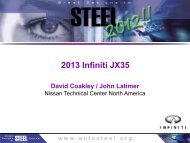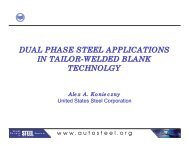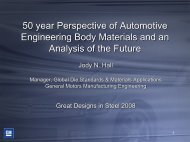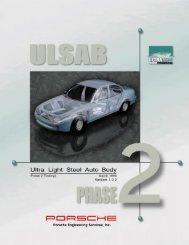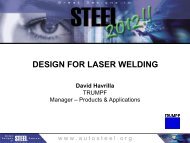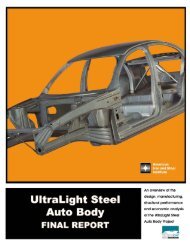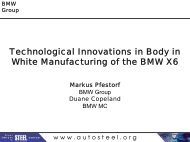Current Trends in Bumper Design for Pedestrian Impact
Current Trends in Bumper Design for Pedestrian Impact
Current Trends in Bumper Design for Pedestrian Impact
You also want an ePaper? Increase the reach of your titles
YUMPU automatically turns print PDFs into web optimized ePapers that Google loves.
SUPPORT (LOAD DISTRIBUTION)<br />
The support function of the bumper system is directly<br />
related to the knee bend angle criterion illustrated <strong>in</strong><br />
Figure 2. It is <strong>in</strong>tended to reduce the risk of severe knee<br />
jo<strong>in</strong>t <strong>in</strong>juries such as ligament ruptures and <strong>in</strong>tra-articular<br />
fractures. The goal is to provide enough support below<br />
and/or above the ma<strong>in</strong> bumper to limit the bend<strong>in</strong>g<br />
moment at the knee jo<strong>in</strong>t dur<strong>in</strong>g an impact. This<br />
situation is complicated by two vehicle design<br />
requirements:<br />
• The vehicle damageability standard <strong>for</strong> bumpers<br />
requires the front bumper to be located at<br />
approximately the same height as the pedestrian<br />
‘leg-<strong>for</strong>m’ knee. So without other support, the<br />
greatest bend<strong>in</strong>g moment would occur at the knee.<br />
This standard also mandates no damage to other<br />
vehicle components, limit<strong>in</strong>g their location.<br />
• The ground clearance and approach angle<br />
requirements limit how low to the ground any<br />
components can be located.<br />
The goal <strong>in</strong> the design of bumper components to support<br />
the lower limb dur<strong>in</strong>g a pedestrian impact is to limit the<br />
‘leg-<strong>for</strong>m’ bend<strong>in</strong>g without either (a) sacrific<strong>in</strong>g vehicle<br />
damageability, or (b) violat<strong>in</strong>g vehicle approach angles.<br />
The literature and patent review identified different<br />
approaches to meet this goal. As above, these are<br />
summarized <strong>in</strong> order of decreas<strong>in</strong>g popularity, as<br />
measured by the number of patents describ<strong>in</strong>g each<br />
solution. An example patent is listed <strong>for</strong> each.<br />
Fixed Lower Stiffeners – 41 patents describe a new<br />
stationary component to be positioned below the bumper<br />
system to prevent the lower part of the ‘leg-<strong>for</strong>m’ from<br />
<strong>in</strong>trud<strong>in</strong>g further than the knee. This is typically called a<br />
‘lower stiffener’ or ‘spoiler,’ though occasionally is<br />
referred to as a ‘cow catcher’ based on its functional<br />
resemblance to that device. The differences <strong>in</strong> these<br />
design proposals have ma<strong>in</strong>ly to do with manufactur<strong>in</strong>g<br />
and attachment:<br />
• Metal beam (11 patents, see GB 2069940) – a metal<br />
structural beam (often fronted with foam) can<br />
provide the required stiffness.<br />
• Plastic tray (11 patents, see EP 1409295) – a plastic<br />
plate is an alternative method <strong>for</strong> this component.<br />
• Extended structure (8 patents, see US 6676179) –<br />
the lower front structure of the vehicle (especially if a<br />
molded front-end module) can be extended <strong>for</strong>ward<br />
and fronted with foam.<br />
• Re<strong>in</strong><strong>for</strong>ced cover (5 patents, see JP 2002144988) –<br />
the lower edge of a plastic bumper cover can be<br />
re<strong>in</strong><strong>for</strong>ced, either through <strong>in</strong>serts, add-on<br />
components, or <strong>in</strong>jection mold<strong>in</strong>g.<br />
• Eng<strong>in</strong>e undertray (3 patents, see US 6540275) – an<br />
exist<strong>in</strong>g eng<strong>in</strong>e undertray can be extended <strong>for</strong>ward.<br />
• Damper-mounted (3 patents, see EP 557733) – any<br />
stand-alone structural stiffener can be mounted to<br />
dampers to limit the <strong>for</strong>ce applied to the leg-<strong>for</strong>m.<br />
Deploy<strong>in</strong>g Lower Stiffeners – Ten patents describe<br />
stand-alone lower structural members that deploy<br />
<strong>for</strong>ward be<strong>for</strong>e impact. Deployment is based on either<br />
object detection or speed (see JP 2004074972).<br />
Mechanical L<strong>in</strong>kages – Three patents describe a lower<br />
stiffener that is connected by a mechanical l<strong>in</strong>kage to the<br />
bumper face. Pressure on the bumper face <strong>for</strong>ces the<br />
lower stiffener <strong>for</strong>ward (see GB 2321624)<br />
Deploy<strong>in</strong>g Upper Structures – Two patents describe a<br />
deployable stiffener mounted above the bumper system,<br />
to prevent excessive knee bend angle by stopp<strong>in</strong>g the<br />
upper part of the leg-<strong>for</strong>m and pedestrian (see US<br />
6447049).<br />
Broad Face <strong>Bumper</strong>s – Two patents describe bumpers<br />
with a tall front-view height to provide support without<br />
additional structures (see GB 2336812).<br />
Note that <strong>in</strong> addition to these specific design features,<br />
the patent and literature search also <strong>in</strong>dicated that<br />
designs that provide improved ‘cushion<strong>in</strong>g’ of the lower<br />
limb (e.g., foam shape/profile, multi-density foam, and<br />
pedestrian ‘bull-bars’) can also be used to help reduce<br />
knee bend angle dur<strong>in</strong>g the pedestrian impact.<br />
DISCUSSION<br />
DESIGN TRENDS<br />
Several common design trends can be identified based<br />
on the results of this survey. These represent<br />
alternative approaches to meet<strong>in</strong>g the requirements of<br />
pedestrian leg impact. As bumper systems meet<strong>in</strong>g<br />
these requirements are only beg<strong>in</strong>n<strong>in</strong>g to hit the market<br />
<strong>in</strong> Europe, Australia, and Japan, it is too early to state<br />
def<strong>in</strong>itively which approaches will eventually be the most<br />
common. However, the preponderance of certa<strong>in</strong> types<br />
of designs <strong>in</strong> the patent archives can provide some<br />
assessment of the likelihood of each trend to be<br />
implemented. A list of the key trends follows, <strong>in</strong> order of<br />
the probability of implementation.<br />
Lower stiffeners (deploy<strong>in</strong>g or static). Most bumper<br />
designs <strong>for</strong> pedestrian impact <strong>in</strong>clude some type of<br />
lower stiffener. There are many ways of deliver<strong>in</strong>g the<br />
function of this part, as reflected by the breadth of<br />
design proposals <strong>in</strong> this area. The key challenges faced<br />
by all of them are durability and vehicle styl<strong>in</strong>g. The<br />
location of the component virtually ensures contact with<br />
curbs, and results <strong>in</strong> visible changes to the vehicle’s<br />
front end. Deploy<strong>in</strong>g stiffeners are less likely to f<strong>in</strong>d



